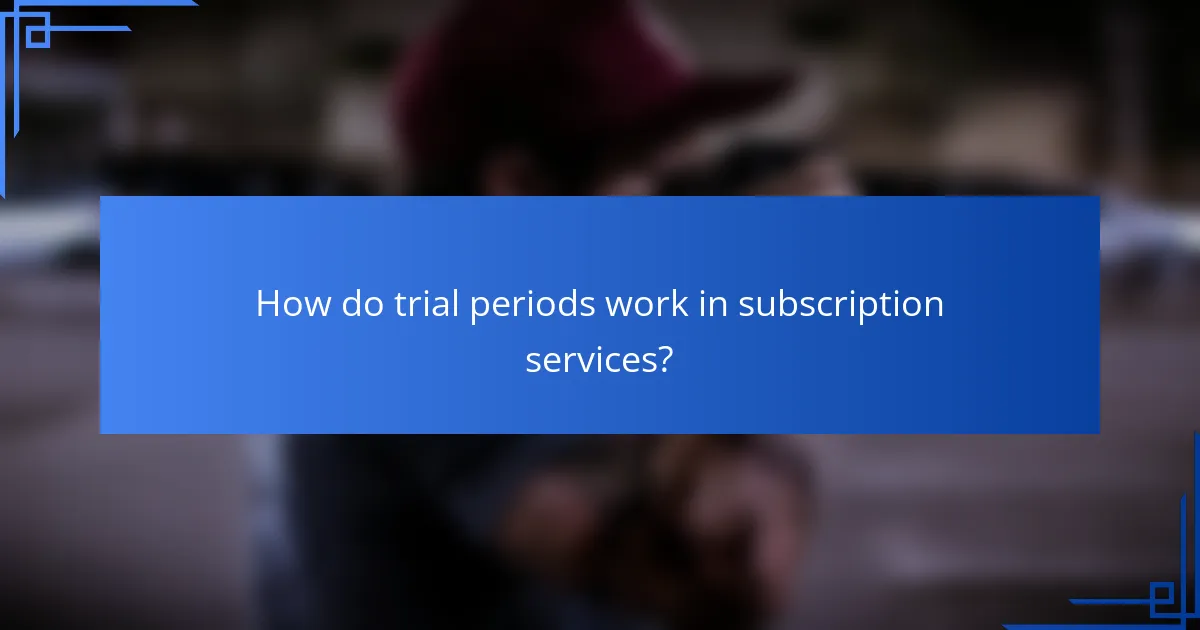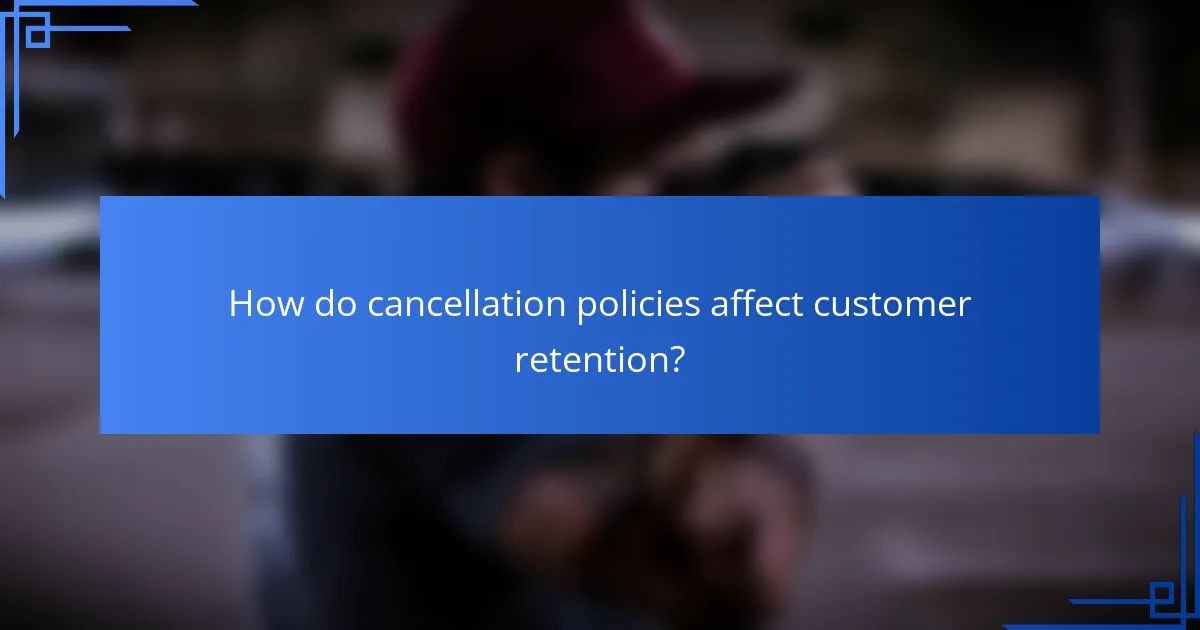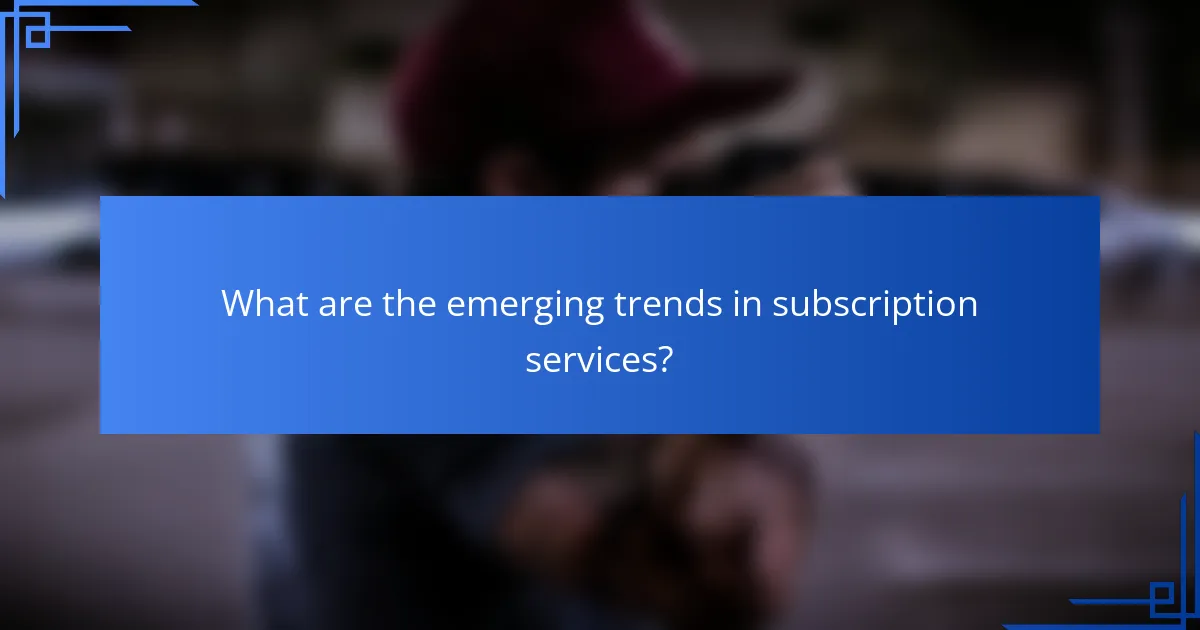Subscription services have evolved to prioritize customer satisfaction through flexible cancellation policies and trial periods. These features empower users to explore services without long-term commitments, allowing for easy opt-out options and risk-free evaluations. By incorporating adaptability and customization, these services cater to individual preferences, enhancing overall user experience and retention.

What are flexible cancellation policies in subscription services?
Flexible cancellation policies in subscription services allow customers to easily cancel their subscriptions without facing significant penalties or restrictions. These policies enhance user experience by providing the freedom to opt-out at any time, often with a straightforward process.
Definition of flexible cancellation
Flexible cancellation refers to the terms and conditions that enable subscribers to terminate their service agreements with minimal hassle. This may include options for immediate cancellation, prorated refunds, or no cancellation fees. Such policies are designed to accommodate customer needs and preferences.
Benefits for consumers
Consumers benefit from flexible cancellation policies as they provide peace of mind and reduce the risk of being locked into unwanted commitments. This flexibility encourages users to try new services without fear of long-term obligations. Additionally, it fosters trust between the service provider and the customer, enhancing overall satisfaction.
Examples of companies with flexible policies
Several companies are known for their flexible cancellation policies, making them appealing choices for consumers. For instance, streaming services like Netflix and Hulu allow users to cancel their subscriptions at any time without penalties. Similarly, subscription boxes like Birchbox often provide easy cancellation options, allowing customers to manage their subscriptions according to their needs.

How do trial periods work in subscription services?
Trial periods in subscription services allow users to access the service for a limited time without charge, typically ranging from a few days to a month. During this period, users can evaluate the service’s features and benefits before committing to a paid subscription.
Typical duration of trial periods
Trial periods usually last between 7 to 30 days, depending on the service provider. Some platforms may offer shorter trials for specific features, while others might extend the trial duration to attract more users. It’s common for streaming services to provide a 30-day trial, while software applications might offer a week-long trial.
Benefits of trial periods for users
Trial periods provide users with the opportunity to explore a service without financial commitment, allowing them to assess its value. This can lead to informed decisions about whether to subscribe long-term. Additionally, users can test compatibility with their needs and preferences, reducing the risk of buyer’s remorse.
Moreover, trial periods often come with full access to features, enabling users to experience the service as intended. This can help in identifying any potential issues or limitations before making a financial commitment.
Popular services offering trial periods
Many well-known subscription services offer trial periods to attract new customers. For instance, streaming platforms like Netflix and Hulu typically provide a 30-day free trial. Software services such as Adobe Creative Cloud and Microsoft 365 often include a 7-day trial for users to explore their extensive features.
Other examples include fitness apps like Peloton and meal kit services such as HelloFresh, which may offer trials ranging from a week to a month. These trials help users experience the service firsthand, increasing the likelihood of conversion to a paid subscription.

What are the best practices for adaptable subscription services?
Best practices for adaptable subscription services include offering flexible cancellation policies, trial periods, and customization options. These features enhance customer satisfaction and retention by allowing users to tailor their subscriptions to fit their needs.
Key features of adaptable subscriptions
Adaptable subscriptions typically include flexible cancellation policies that allow users to end their service without penalties. Trial periods are another essential feature, enabling customers to test the service before committing long-term. Customization options, such as selecting specific features or content, further enhance user experience.
Additionally, easy-to-navigate user interfaces and clear communication about terms and conditions are crucial. Transparency in billing and service changes fosters trust and encourages users to engage with the service.
Consumer preferences for adaptability
Consumers increasingly prefer subscription services that offer adaptability, valuing the ability to modify or cancel their plans without hassle. Research indicates that a significant portion of users is more likely to subscribe to services with clear trial periods and flexible terms. This preference highlights the importance of customer-centric policies in retaining subscribers.
Moreover, many users appreciate the option to pause subscriptions rather than cancel them outright, allowing for a more tailored approach to service usage. This flexibility can lead to higher customer loyalty and reduced churn rates.
Case studies of successful adaptable services
One notable example is Netflix, which offers a free trial period and allows users to cancel their subscriptions at any time. This approach has contributed to its massive subscriber base and high retention rates. The ability to customize viewing preferences also enhances user satisfaction.
Another example is Spotify, which provides a trial period for its premium service and allows users to switch between free and paid plans seamlessly. This adaptability has made Spotify a leader in the music streaming industry, catering to diverse consumer needs and preferences.

How do cancellation policies affect customer retention?
Cancellation policies play a crucial role in customer retention by influencing how customers perceive their commitment to a service. Flexible cancellation options can enhance customer satisfaction and loyalty, making it easier for users to stay engaged with a subscription.
Impact on customer loyalty
Flexible cancellation policies can significantly boost customer loyalty. When customers feel they have control over their subscriptions, they are more likely to continue using the service rather than canceling out of frustration or fear of being locked in. This sense of security fosters a positive relationship between the provider and the customer.
For example, a streaming service that allows users to pause their subscriptions rather than cancel them outright can maintain a larger customer base. Customers appreciate the ability to return without hassle, which encourages them to remain loyal even during periods of inactivity.
Statistics on cancellation rates
Research indicates that subscription services with flexible cancellation policies experience lower cancellation rates compared to those with rigid terms. Many companies report that offering a trial period or easy cancellation can reduce churn by a notable percentage, often in the low double digits.
For instance, a subscription box service that allows customers to cancel anytime may see cancellation rates drop to around 20% or lower, while those with strict policies might face rates exceeding 30%. These statistics highlight the importance of adaptable policies in retaining customers.
Strategies to improve retention
To enhance customer retention, businesses should implement clear and flexible cancellation policies. Providing a straightforward cancellation process and transparent terms can build trust and reduce customer anxiety about long-term commitments.
Additionally, offering incentives such as discounts for long-term subscriptions or personalized follow-ups can encourage customers to stay. Regularly communicating with customers about their options and any changes to policies can also reinforce their sense of control and satisfaction.
- Make cancellation easy and transparent.
- Offer incentives for longer commitments.
- Communicate regularly with customers about their options.

What criteria should you consider when choosing a subscription service?
When selecting a subscription service, consider factors such as cancellation policies, trial period offerings, and adaptability features. These criteria can significantly impact your overall satisfaction and flexibility with the service.
Evaluating cancellation policies
Cancellation policies dictate how easily you can terminate your subscription without penalties. Look for services that offer hassle-free cancellation options, ideally allowing you to cancel online without needing to contact customer support.
Some services may have a minimum commitment period, while others allow you to cancel at any time. Always read the fine print to understand any potential fees or notice periods required for cancellation.
Assessing trial period offerings
Trial periods let you test a subscription service before committing financially. Many services offer trials ranging from a week to a month, giving you a chance to evaluate their features and usability.
During the trial, pay attention to the service’s performance and whether it meets your needs. Ensure you know when the trial ends to avoid unexpected charges. Some services may require you to provide payment information upfront, so be cautious if you prefer not to be charged automatically.
Comparing adaptability features
Adaptability features refer to how well a subscription service can adjust to your changing needs. Look for options that allow you to easily upgrade, downgrade, or pause your subscription based on your usage or financial situation.
For example, some streaming services let you switch between plans or temporarily suspend your account without losing your data. Evaluate these features to ensure the service can accommodate your lifestyle changes, such as travel or budget constraints.

What are the emerging trends in subscription services?
Emerging trends in subscription services include a shift towards personalized models, flexible cancellation policies, and the increasing popularity of trial periods. These trends reflect consumer demand for adaptability and tailored experiences in their subscriptions.
Growth of personalized subscription models
Personalized subscription models are gaining traction as companies leverage data to tailor offerings to individual preferences. This approach enhances customer satisfaction by ensuring that subscribers receive products or services that align closely with their interests.
For instance, streaming services often use viewing history to recommend shows and movies, while subscription boxes may curate items based on user profiles. This level of customization can lead to higher retention rates, as customers feel valued and understood.
When considering personalized subscriptions, businesses should focus on collecting relevant data while respecting privacy regulations. Offering options for subscribers to modify their preferences can further enhance the personalization experience.
